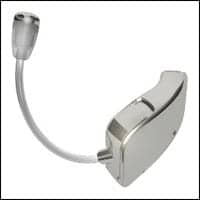Tech Topic | April 2020 Hearing Review
By Laura Winther Balling, PhD; Oliver Townend; Georg Stiefenhofer, MSc, and Wendy Switalski, AuD, MBA
Sound quality in digital hearing aids is often compromised due to signal-processing delay and the resulting “comb-filter effect.” To change this, Widex recently introduced a new solution, designed particularly for mild-to-moderate hearing losses, which employs an ultralow delay. This results in a sound quality that has, until now, been unattainable in digital hearing aids. This article describes the physics of hearing aid delay, and presents a field study on the sound quality experience of the new system.
There are many reasons why people find it hard to adjust to hearing aids, but prominent among them is the sound: no matter how good a hearing aid is, it always sounds like a hearing aid. A significant cause of this is the “comb-filter effect,” which arises because the digital signal processing in the hearing aid delays the amplified sound relative to the direct sound that enters the ear through venting in the ear tip and any leakage around it. Even if this delay is just a few milliseconds, it makes the amplified and direct sounds move in and out of phase, leading to peaks and troughs in the gain-frequency curve of the combined signal that are not present in the original signal. The graphic depiction of the comb-filter effect resembles the teeth of a comb (eg, see Figure 2).
The comb-filter effect is perceived as a distorted, hollow, unnatural sound, somewhat like listening through a tube or a seashell. This is obviously not an attractive sound quality, but it has, until now, been an unavoidable part of digital hearing aids except in entirely closed fittings. For open and vented fittings, the inherent delay of the digital signal processing that enables great features like environmental analysis, noise reduction, and feedback cancellation results in degraded sound quality when the processed sound mixes with the direct sound.
Now, thanks to a new paradigm in processing, this is no longer a problem. The PureSound™ program in the new WIDEX MOMENT™ hearing aids allows such low delay that the comb-filter effect is practically eliminated, along with its negative effect on sound quality. This article explains how this technology is employed, then presents a study that shows how reduced delay results in a superior sound quality across real-life situations.
The Physics of Delay
As described, the comb-filter effect is a result of the direct sound entering the ear canal and mixing with the delayed hearing aid sound. This means that the problem is greatest for completely open ear tips. However, as seen in a previous study,1instant ear tips are rarely entirely closed. Since instant ear tips account for approximately 82% of hearing aid sales in the United States,2 distortion due to comb-filtering is a potential problem for many hearing aid users.
The comb-filter effect is particularly audible for users with mild-to-moderate hearing losses who are in turn likely to have the open and vented fittings where the problem is most prominent. The effect is most pronounced when the two sound contributions are of approximately equal amplitude, typically between 0.5 and 2 kHz, depending on the ear tip, ear canal, and hearing aid gain.
The typical delays for premium hearing aids are around 5 to 8 msec, though the delay in Widex hearing aids has long been lower, primarily due to the applied time-domain filter bank. Figure 1 shows the group delays of four different premium hearing aids along with the delay of Widex PureSound™, a new program based on ZeroDelay™ technology. The delay in the PureSound program, shown in light blue, is clearly in a category of its own.
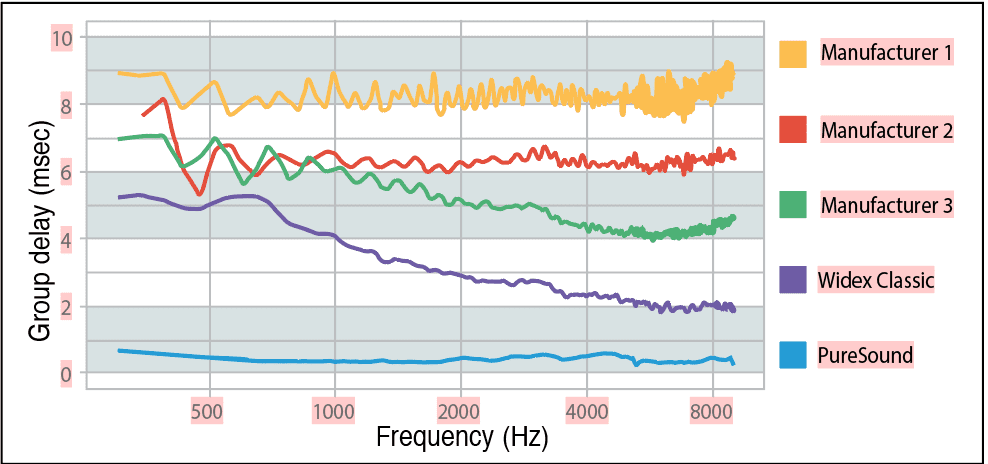
Although average delays of 3, 5, or even 8 milliseconds appear short, even these short delays affect the sound at the eardrum, with distortion due to comb-filtering found for all these delays in open and vented fittings (Figure 2). This physical effect of delay has until now been an unavoidable price for the benefits of digital signal processing, which could only be avoided by turning off gain in the channels up to 2 kHz. This in turn may reduce audibility.
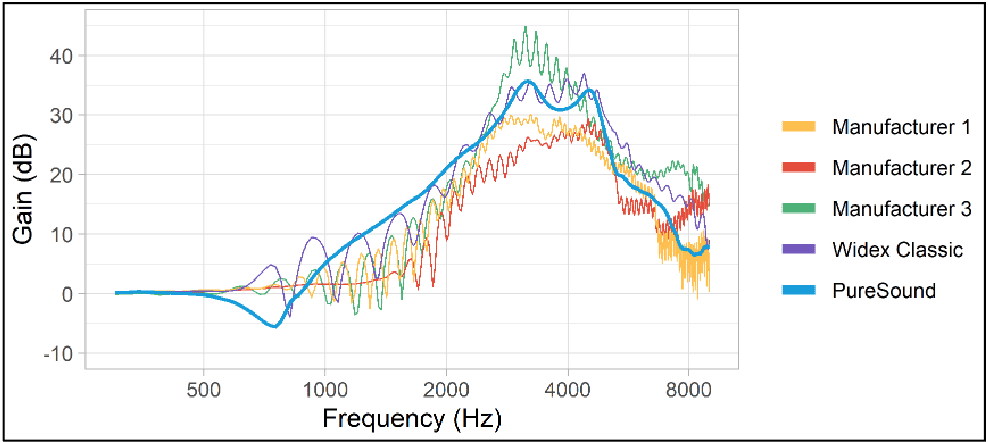
Widex ZeroDelay technology avoids this distortion by achieving a mean delay of less than half a millisecond. This feat is made possible by a hearing aid platform with two signal pathways: the Widex Classic signal pathway, powering the Universal and specialized programs, and the new ZeroDelay pathway that the PureSound program is based on. The Classic pathway contains all the digital signal processing features you would expect from a Widex device, while the ZeroDelay pathway uses adapted versions to deliver sound with almost no comb-filter effect.
As this pathway relies on practically instantaneous delivery of sound, some features are adapted, but they still target signal-to-noise ratio improvements and instant feedback control. Thus, the PureSound program includes most of the features that we have come to expect from digital hearing aids, including individualized gain and multi-kneepoint compression, noise reduction, and automatic detection and adjustment to the surroundings. This makes the PureSound program suitable for general use, providing superior sound quality for users with mild-to-moderate hearing losses.
How Long a Delay is Tolerable?
Delay was negligible in analog hearing aids, but with the introduction of digital hearing aids it became important to account for, since digital signal processing takes time. Moreover, the increased use of open fittings means that direct sound plays a larger role in more fittings.
For these reasons, research has focused on how much delay hearing aids can introduce before it becomes intolerable. For example, Stone and Moore published a 5-part series of papers from 1999 to 2008 on “Tolerable Hearing Aid Delay”,3-7 where they investigated how different delays disturbed the listening experience.
Previous research varies a lot in terms of which delays and processing aspects were investigated, whether participants had hearing loss, and how hearing aid sound was produced or simulated. In general, there has been a consensus that delays below 10 msec are probably acceptable,8 though Stone et al7 indicated that delays may need to be less than 5 or 6 msec to be acceptable, and Dillon et al9 showed a relation between delay and preference scores.
In terms of understanding how delay-based distortion affects sound quality, there are two problems with this previous research: First, it has primarily focused on when delay becomes directly objectionable, which is of course important but not very informative about the precise relation between delay and sound quality. Second, due to technical constraints in previously available hearing aid technology, most research has used delays from 2 msec upwards, without a no-delay baseline.
However, Figure 2 shows that even a delay of around 2 msec results in clear comb-filtering, while ultralow delay below 0.5 msec does not. This fundamentally changes the question from one of tolerable delay (ie, “How much delay can we get away with?”) to a question of how optimizing delay may help us achieve optimal sound quality.
The link between ultralow delay and sound quality was explored in the following real-life study.
Optimizing Delay for Great Sound Quality
A crucial question is how the shorter delay for Widex PureSound (Figure 1) and the resulting absence of comb-filtering (Figure 2) translate into listener experiences. This question was addressed in a guided sound walk study where 21 participants rated the sound quality of the new ultralow delay of Widex PureSound compared with standard hearing aid delay in a double-blind design.
Methods
Participants. A total of 21 participants completed a guided walk. There were 13 participants with mild-to-moderate hearing loss and 8 participants with normal hearing.
Hearing aids. We used a cluster-fit approach in order to keep the study as systematic as possible and to ensure double blinding. The hearing aids for the participants with hearing loss (HL group) were fit to an N2 hearing loss,10 and the hearing aids for the participants with normal hearing (NH group) to a flat hearing loss of 25 dB HL. For three participants in the HL group who habitually had problems with feedback, the hearing loss was set to N2 with 40 dB HL at the highest frequencies.
The HL group consisted of 8 experienced HA users (> 2 years’ regular use) and 5 inexperienced users who had never regularly worn hearing aids.
All hearing aids included two listening programs: the Widex PureSound program and a comparison program with more standard delay (mean group delay of approximately 2.5 msec). Around half the participants had PureSound as Program 1 and the other half as Program 2, and both the participants and the researchers were blinded to the identity of Programs 1 and 2. In order to focus on the effect of delay, all forms of noise reduction were disabled; impulse sound handling and sound classification were deactivated; and beamformers were set to omni-directional. All participants wore open ear tips.
Procedure. The main element of the study was a guided walk to locations in and around the Widex headquarters in Denmark, with 20 sound quality evaluations at 14 different locations. Participants were instructed how to change programs with a remote control and tried out the sound quality evaluation at a location that was not included in the analyses.
The remaining locations were inside and outside with varying types of sounds (see Table 1 for a list of sound scenarios). For each of the scenarios, the participant was instructed to switch between the two programs while listening to the surroundings, a specific sound, their own voice, or the researcher reading aloud. They were then asked whether they preferred the sound quality of Program 1 or 2, by how much they preferred it (“a little better,” “better,” or “a lot better”), and what the reasons for their preference were. Participants could also indicate if they heard no difference or had no preference.
After the guided walk, the participants were interviewed about their overall experience.
Results
Overall preference. The most important outcome of this study was the participants’ overall sound quality preference, which is illustrated in Figure 3. In the exit interview, 85% of the HL group and 100% of the NH group indicated a preference for PureSound over standard delay. This PureSound preference was highly significant (binomial test, p < 0.001). The preference is, of course, most relevant for the HL group, since they belong to the PureSound target group. However, it is also interesting that a group of normal-hearing participants so clearly preferred the program with ultralow delay. This shows that delay has a strong influence on what is perceived as natural sound.
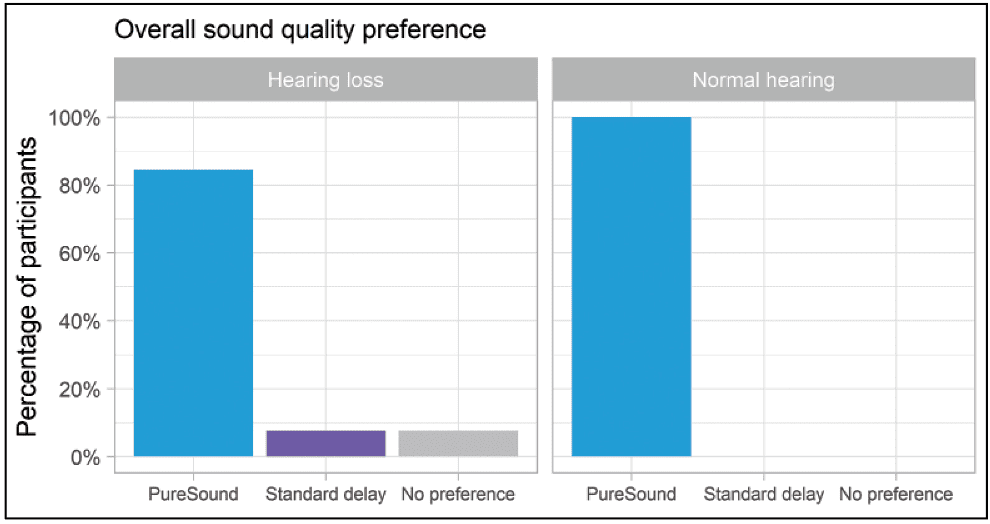
Of the only two participants who did not prefer PureSound, one had quite severe tinnitus, which may have affected his ability to hear the comb-filtering, and the other did not indicate an overall preference.
In addition to the participants’ overall preference, it is also relevant to explore their answers in individual scenarios. Here we see that the participants with the overall PureSound preference also showed a majority of preferences for PureSound across the 20 scenarios they rated, indicating that participants were systematic in their preferences. A Wilcoxon signed-rank test showed a significantly higher number of PureSound preferences than standard delay preferences across situations (W = 222, p = 0.0002), with over 3 times as many PureSound preferences as standard delay preferences.
Preference by situation. Having established an overall sound quality preference for ultralow delay, we next investigated whether this preference varied between sound scenarios. We know already that the preference was found in most scenarios for all except two participants, but the question is whether this was more due to particular sound scenarios.
Looking at individual scenarios, the majority of preferences were for PureSound in all scenarios. The percentage of PureSound preferences ranged from 53% (inside with loud ventilation, where the comb-filter effect is perceived as changing the pitch of the ventilation noise rather than sounding artificial as it does in other situations) to 100% (traffic noise).
The scenarios included in the guided walk constitute a broad selection that represent many different real-life situations. Although they are thus fairly diverse, the situations may be grouped into seven different sound categories, as shown in Table 1. This again shows a majority of PureSound preferences, on approximately the same level for most categories, except traffic noise, which stands out with 100% of participants preferring PureSound.
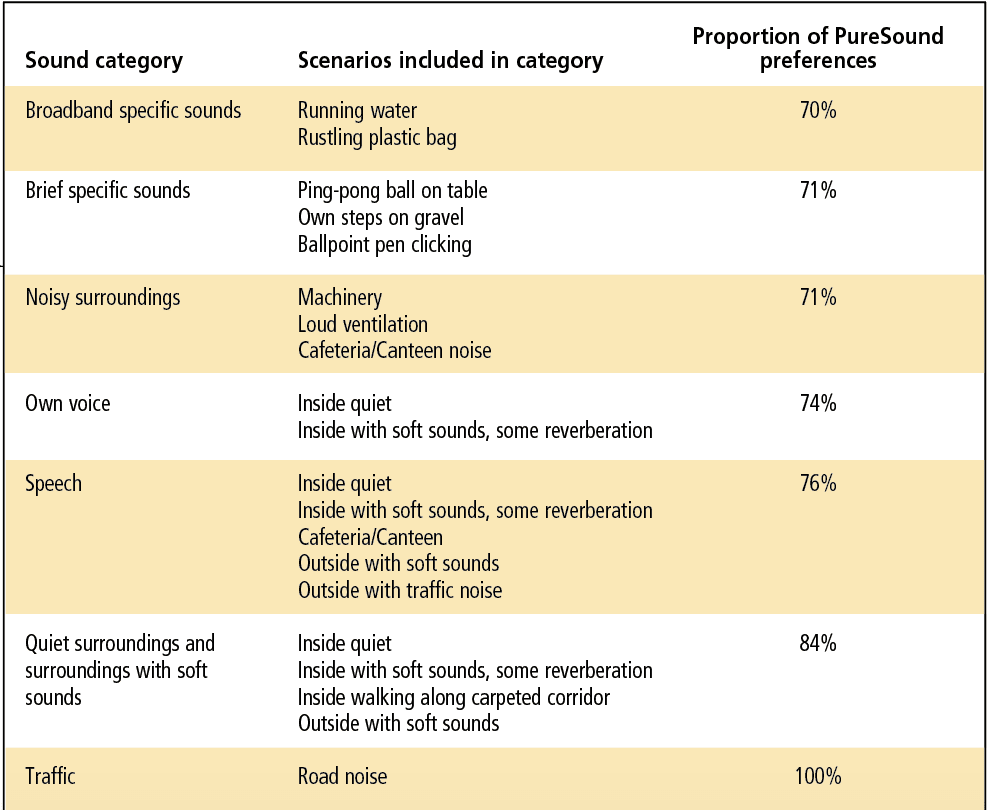
We can also look at the mean preference ratings as illustrated in Figure 4, where the “how much better” answers have been translated into a scale from -3 (standard delay much better) to +3 (PureSound much better). This confirms the picture of a consistent PureSound preference, with traffic noise standing out with a particularly strong advantage. For all categories of situations, Wilcoxon signed-rank tests show that the PureSound preferences are significant (all p’s < 0.02).

Preference reasons. A final step for understanding the superior sound quality of ultralow delay is looking at the reasons that participants gave for their preferences. In the exit interview, the 19 out of 21 participants who preferred PureSound gave 39 reasons for their preference, of which the most frequent were “less noise” (13), “more natural” (7), “clearer” (3), and “more nuanced/detailed” (3).
The reasons for the PureSound preferences in individual scenarios echo the same themes: from a total of 310 reasons given, about half were either “less noise” (76) or “more natural” (78). Other prominent reasons included “pleasant” (24), “clearer” (23), “less tunnel/seashell sound” (19), “less high-pitched” (11), and “better speech understanding” (10). Of note is the description of “less noise,” despite the disabling of traditional noise management in this study.
“More natural” also figures among the reasons given for standard delay preferences, with 28 out of 94 total reasons given. Interestingly, this reason was mainly given by experienced hearing aid users who are, of course, used to listeningto standard delay and as such more likely to find it recognizable.
Similarly, there were 10 cases where experienced hearing aid users reported that standard delay included more of the soundscape, while none of the inexperienced users reported this. This again may be due to the experienced hearing aid users being so used to the sound of the comb-filter effect that—in certain situations at least—they interpreted that distortion as a part of the environment that was “missing” in the PureSound program.
Conclusion
The guided walk study clearly showed how the physics of delay affects sound quality for real hearing aid users in real life: the sound of the ultralow delay PureSound program was preferred by a large and significant majority of listeners and in significantly more situations than the program that included a standard delay. This does not mean that PureSound is the right solution for everyone, but it is an ideal option offering superior sound quality for those users with mild-to-moderate hearing loss who are most likely to be disturbed by the comb-filter effect, including entirely new users.
For users with more severe hearing loss, the Widex MOMENT Universal program is still characterized by the Widex focus on great sound quality. Thanks to the possibility of both processing options, the Widex MOMENT hearing aids provide an optimal solution for all, including users who are new to hearing aids and no longer have to struggle with getting used to the sound of delay.

Correspondence can be addressed to Dr Balling at: [email protected]
Original citation for this article: Balling LW, Townend O, Stiefenhofer G, Switalski W. Reducing hearing aid delay for optimal sound quality: a new paradigm in processing. Hearing Review. 2020;27(4):20-26.
References
1. Balling LW, Jensen NS, Caporali S, Cubick J, Switalski W. Challenges of instant-fit ear tips: What happens at the eardrum? Hearing Review.2019;26(12):12-15.
2. Strom K. Hearing aid sales increase by 3.8% in first half of 2019. Hearing Review.2019;26(8):6.
3. Stone MA, Moore, BCJ. Tolerable hearing aid delays. I. Estimation of limits imposed by the auditory path alone using simulated hearing losses. Ear Hear.1999;20(3):182-192.
4. Stone MA, Moore BCJ. Tolerable hearing aid delays. II. Estimation of limits imposed during speech production. Ear Hear. 2002;23(4):325-338.
5. Stone MA, Moore BCJ. Tolerable hearing aid delays. III. Effects on speech production and perception of across-frequency variation in delay. Ear Hear. 2003;24(2):175-183.
6. Stone MA, Moore BCJ. Tolerable hearing-aid delays: IV. Effects on subjective disturbance during speech production by hearing-impaired subjects. Ear Hear. 2005;26(2):225-235.
7. Stone MA, Moore BCJ, Meisenbacher K, Derleth RP. Tolerable hearing aid delays. V. Estimation of limits for open canal fittings. Ear Hear. 2008;29(4):601-617.
8. Dillon H. Hearing Aids. 2nd ed. New York, NY: Thieme Medical Publishers; 2012.
9. Dillon H, Keidser G, O’Brien A, Silberstein H. Sound quality comparisons of advanced hearing aids. Hear Jour. 2003;56(4):30-40.
10. Bisgaard N, Vlaming MSMG, Dahlquist M. Standard audiograms for the IEC 60118-15 measurement procedure.Trends in Amplif. 2010;14(2):113-120.


